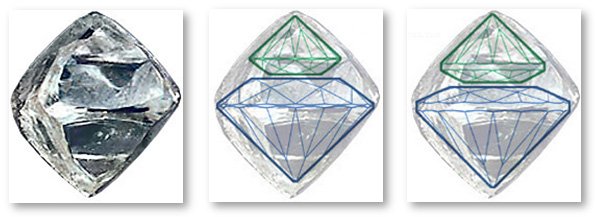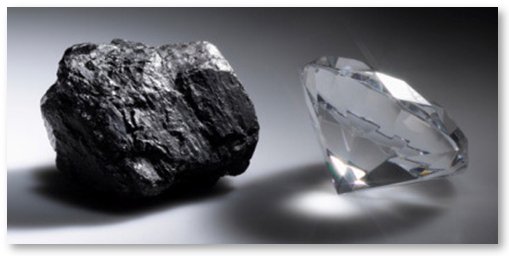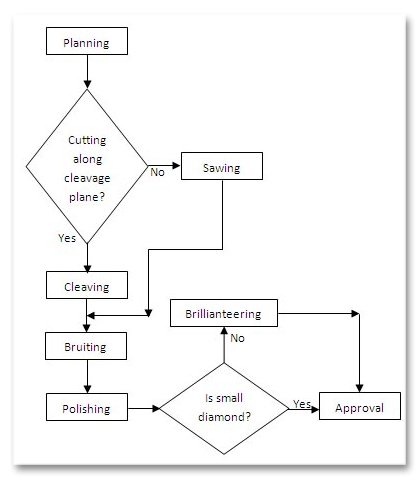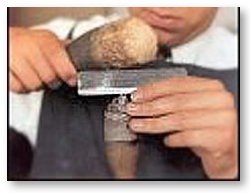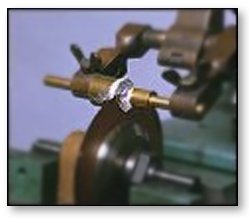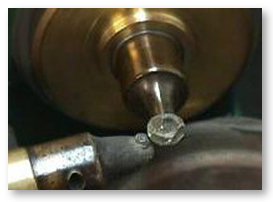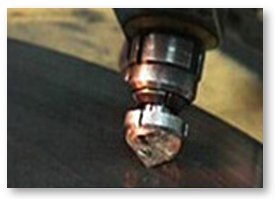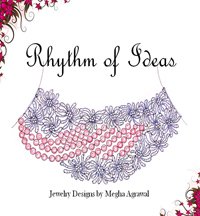Diamond Cutting Process
Diamond Cutting - Science or Art?
Every rough crystal of diamond has unique inclusions and diamond cutters try to remove these inclusions with minimum carat wastage. At the time of cutting, a cutter has to keep following 3 things in mind:
- Cut - This determines the beauty of diamond
- Weight Retention - This impacts the size of diamond
- Removal of Inclusions
Therefore, a cutter has to do a trade-off between above-mentioned 3 points at the time of stone cutting. But quite often, cutters compromise on cut of diamond to come up with large and heavy stone.
Cutting and Weight Retention of Rough Diamond
During cutting process, a properly cut diamond leads to more carat weight loss as compared to shallow or deep cut. Cutter has to cut the rough stone in such manner that stones yields maximum value.
(left to right) Rough Stone, Ideal Cut Diamond, Standard Cut Diamond
As you can see in the image, an octahedral rough stone can be cut into 2 round brilliant cut stones. Now, the cutter will decide to go for "Ideal Cut" if:
- The rough stone falls in color grade range D to F and
- Stone has very few inclusions.
So, Ideal cut is chosen for stones of high quality (color and clarity) in order to further increase the monetary value of diamond, even though there is comparatively more weight loss in this cut.
But, he may go for "Premium or Standard Cut" in order to retain carat weight if:
- The stone has easily visible inclusion as hint of color.
So, Premium cut is chosen for stones which are of low quality and in which further weight loss needs to be avoided in order to maximize the value of diamond.
Techniques used to Cut and Polish Diamonds
The diamonds that you see are actually found in the form of rough crystal, which may appear quite boring and ordinary at a first glance :-). To bring out the brilliance and sparkle from the rough stone, it requires great skill and art of the trained diamond cutter.
Rough and Finished Diamond
The process of diamond cutting is a long complicated work and this process is called Lapidary. It includes cutting, shaping, polishing, and setting of finished diamond into jewelry.
These days computerized machinery and laser technology is also used for diamond cutting. But technology is employed only in the cutting of some of the diamonds. Otherwise, cutting process is still done by hand. Cutting skill is passed on from one generation to another.
Now, let’s talk about the Lapidary process in detail.
Lapidary Process
Flow Chart of Diamond Cutting Process
Planning
This is the first stage of diamond cutting process. Rough crystal is first analyzed from economics point of view. Final shape of diamond is decided so as to retain its maximum weight along with removal of inclusions. These considerations are given so that the stone gets easily sold and fetches the maximum value.
Cleaving
In this stage large rough crystal is divided into separate pieces so that all pieces can be finished as separate diamonds. Cleaving becomes important for large and valuable stone. But all diamonds do not need to be cleaved or sawed. Some rough crystals are found in good shape so those are directly passed to cutting stage.
Cleaver places the rough diamond in quick drying cement. Then a groove is cut along the crystallographic planes (the hardness of diamond and its ability to cleave depends on the crystallographic direction i.e. on the strength of the bonds between atoms in a crystal) using another diamond as a cutting tool.
Then rough diamond is mounted on a holder and a steel blade is placed in the groove. Cutter then strikes the blade sharply and the diamond splits along its cleavage. Then the cleaved stone is removed from the cement.
Sawing
When the diamonds need to be cut against a cleavage plane, sawing is considered as it cannot be done by cleaving. The saw is a thin blade of phosphor bronze that rotates on a horizontal spindle. As the saw blade rotates, it continues to recharge itself with diamond dust from the crystal being cut. Due to this it takes several hours to cut even a 1 carat rough diamond.
It has to be noted that either of Cleaving or Sawing is done on a rough stone, which depends on the way the stone has to be cute.
Bruiting
In this stage, diamond to be bruited is spun on a rotating lathe, and another diamond in the lathe is rubbed against it. This leads to rounding of rough diamond into a conical shape by grinding away the pointed edges. Therefore, this process is also called "Rounding". Since this process creates the rough finished girdle, so it also called "Girdling".
Polishing
Polishing is the final stage of the cutting process when facets are cut on the diamond and final polishing is done.
In this stage, blocking is the first step. In a round diamond, the "blocker" polishes 18 facets (table, bezel, culet and pavilion main facets). It’s done on electric motor driven revolving cast iron polishing disc. The disc is charged with diamond powder. The diamond to be polished is held by a clamp and facets are polished one by one.
Facets must be cut to an exact measurements and angles to maintain symmetry and yield maximum brilliance. In case of very small diamonds, polishing process stops here but larger diamonds proceed to Brillianteering stage.
Brillianteering
Cutter cuts and polishes large diamonds for another 40 facets (star, upper girdle and lower girdle facets) to create round brilliant cut with 58 facets. So, it is this faceting that gives life to the stone by enhancing its brilliance and fire.
Approval
After faceting is complete, diamond is inspected and approved and then it is boiled in hydrochloric and sulfuric acids to remove dust and oil.
Finally, the cutting and polishing process is complete and diamond is ready to be set in jewelry to start its new and life-long journey :-).
Return from Diamond Cutting Process to Cuts of Diamond page
Return from Diamond Cutting Process to Diamond Jewelry Homepage
I hope you'll not mind sharing this on Twitter, Facebook and with everyone else :)
Feel free to share if something is in your mind and want it to be covered on this site.
My Newsletter
Did you liked this article? Sign-up my FREE weekly newsletter and I'll send you more awesome new additions on this website along with latest jewelry happenings around the world, and download my Jewelry Design Album for FREE!
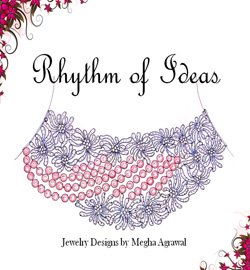 |
|
